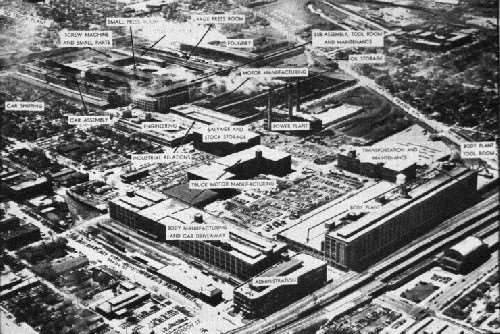Re: New "What Ifs?"
Posted by Steve203 On 2014/8/13 11:42:47
The days of plants like EGB were roundly over for large scale production. Buick kept going in a few plants like EGB for years, AMC, in their own cash-poor way did so out of necessity, but the war really changed how large scale production happened.
As discussed, a multistory plant, that is paid for and structurally sound, can be competitive vs walking away from it for a new one. Cadillac Clark St, Dodge Main and Chrysler on Jefferson were all about as old as EBG, with the same multi-story layout, but operated into the 80s.
The move to one story plants started with the availability of electric conveyors. The Graham-Paige plant I posted about above was built in the 20s. Plymouth on Lynch Rd was built in 29.
He told me about walking down this dark hallway, a flickering fluorescent light every so often, plaster falling, laying in little piles on the floor--
Yup, things the public doesn't see are the first to go. When Sherwood Egbert took over as President of Studebaker, he instituted a "clean up, paint up" program around the complex, which had been let go for a long time, as a try at improving worker morale. Palazuelo's assistant's father had been a steel buyer at Packard. She says he quit in 52, "because he could see the writing on the wall".
Packard was burying their heads in the sand by ballywhooing the East Grand Boulevard square footage over Willow Run.
Well, they wouldn't be the first guys arguing about who had a bigger one.
EGB really wasn't that bad from a workflow standpoint. Body trimming at the south end, then the bodies move north to where frame buildup is done. Drop the two together and done.
Compare that to the chaos at Studebaker. On this photo, look at where the stamping plants are, then look at where the body plants are, then look at where final assembly is.
Attach file:
 (81.14 KB)
(81.14 KB)

As discussed, a multistory plant, that is paid for and structurally sound, can be competitive vs walking away from it for a new one. Cadillac Clark St, Dodge Main and Chrysler on Jefferson were all about as old as EBG, with the same multi-story layout, but operated into the 80s.
The move to one story plants started with the availability of electric conveyors. The Graham-Paige plant I posted about above was built in the 20s. Plymouth on Lynch Rd was built in 29.
He told me about walking down this dark hallway, a flickering fluorescent light every so often, plaster falling, laying in little piles on the floor--
Yup, things the public doesn't see are the first to go. When Sherwood Egbert took over as President of Studebaker, he instituted a "clean up, paint up" program around the complex, which had been let go for a long time, as a try at improving worker morale. Palazuelo's assistant's father had been a steel buyer at Packard. She says he quit in 52, "because he could see the writing on the wall".
Packard was burying their heads in the sand by ballywhooing the East Grand Boulevard square footage over Willow Run.
Well, they wouldn't be the first guys arguing about who had a bigger one.
EGB really wasn't that bad from a workflow standpoint. Body trimming at the south end, then the bodies move north to where frame buildup is done. Drop the two together and done.
Compare that to the chaos at Studebaker. On this photo, look at where the stamping plants are, then look at where the body plants are, then look at where final assembly is.
Attach file:
 (81.14 KB)
(81.14 KB)
This Post was from: https://packardinfo.com/xoops/html/modules/newbb/viewtopic.php?post_id=148490